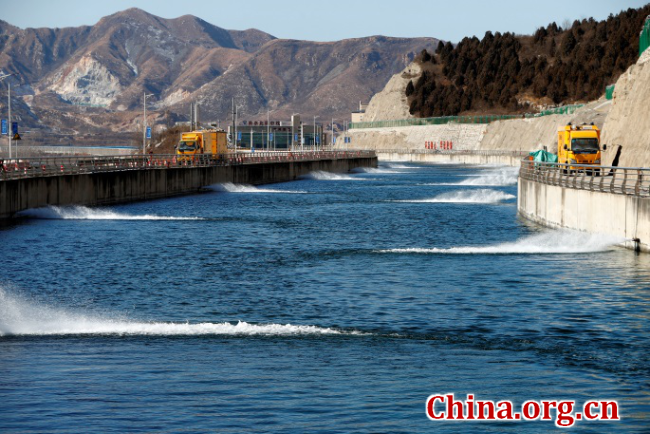Winter water diversion project on central route ends
On Feb. 28, the central route of the South-to-North Water Diversion Project concluded its water transfer during this winter's freezing period, having successfully transferred 1.263 billion cubic meters of water in total.
On Feb. 28, the central route of the South-to-North Water Diversion Project concluded its water transfer during this winter's freezing period, having successfully transferred 1.263 billion cubic meters of water in total. The Construction and Administration Bureau of the central route of the South-to-North Water Diversion Project ensured safe and stable transfer of water during winter, keeping a rescue team and equipment on call at all times and implementing strong emergency measures.

The water transfer project along the central route was expanded during the freezing period to ensure adequate water supply to Tianjin. Workers used specialized devices to block the formation of ice, and to melt and drain ice in weaker sections of the water transfer. The Xihei Mountain check gate of the Tianjin main line transferred 27 cubic meters of water per second during the winter months to maintain water stores for Tianjin residents.
The General Management Center of the Construction and Administration Bureau served as the hub for the project, including preparations and ongoing monitoring of the operation. The 2018-2019 water delivery plan was created in advance, outlining and anticipating important factors. Once the transfer began, the team strictly controlled water levels and the flow of transfer, and kept a close watch on the weather, monitoring changes in water temperature and ice formation. Information was shared among management centers at all levels, thus creating a network to exchange ice impact data daily.
"Our work load was heavier than those offices without winter water transfer duties," said Zhu Yunzhi, director of the Xihei Mountain Management Office of the central route. During the freezing season, he said, project inspection increased in frequency, and ice information was updated regularly, including monitoring of shore ice and floating ice, and the time and location of any melting. Equipment and machinery was examined and maintained intensively, including the diesel generators and ice melting devices used for the project.
Emergency readiness was made a high priority during the project's running, with ropes installed at the entrances of aqueducts to prevent ice from flowing into them. In danger-prone areas, ice breaking and ice draining machines were kept on hand.
"We requested that every management office hold training classes on winter water delivery," said Tian Yong of the Hebei branch of the Construction and Administration Bureau. The training provided staff with instruction about the particular challenges and dangers of managing water transfer in freezing temperatures, and improved their emergency response preparedness.
The Construction and Administration Bureau of the project listed three high-risk points along the route: Gangtou gate station, Xihei Mountain gate station and Beijuma gate station. At those points, inspection for drifting ice at the tunnels and gate entrances was conducted continuously. According to Zhu Yunzhi of the Xihei Mountain Management Office, the emergency team on the worksite conducted rescue drills every day and kept the machines running and available at all times in case of an emergency.
Workers conduct a safety inspection along the Caohe aqueduct, part of the central route, in northern China's Hebei province.

